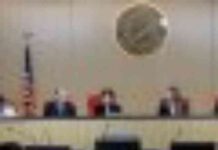(Seattle) A dispute system allowing appeals seems to be the preferred solution to the dilemma of automated catch zones.
MLB is testing ABSS, the Automated Ball and Strike System, at the AAA level this season. The computer makes the decisions for half the game. In the other half, batters, pitchers and catchers can challenge decisions made by an umpire with the automated system.
The system was used in the Prospects game at T-Mobile Park on Saturday. The human arbitrator won three of the four challenges.
According to commissioner Rob Manfred, people in the minor leagues are more comfortable with this challenge system.
Last month, Manfred indicated that a fully automated system would not be ready for the 2024 season. The size of the automated catch zone is still debated. A decision will be made by the competition committee, made up of 11 members: six MLB representatives, four players and a referee.
Among other topics discussed with members of the Baseball Writers Association of America (BBWAA) on Tuesday, MLB said it was considering balls that would not need to be battered with dirt as a possible way to solve the problem of sticky materials used to have a better grip.
Manfred said Major League Baseball is working with Dow Chemicals to develop a sticky ball, which would eliminate many of the variables in the current process. The balls would arrive individually wrapped in a foil pouch and would require no rubbing with the clay courts that have been used for decades. This procedure was standardized among the 30 teams last year.
The balls were tested in the first half of the season in the Southern League, at AA level. They would retain their showy seams.
Five pitchers have been suspended for 10 games each for sticky substance use since MLB decided to toughen up the rules in June 2021.
One of Major League Baseball’s great accomplishments this season is the addition of a dial between pitches. Commissioner Manfred, however, indicated that he considered giving more time to pitchers and batters for the playoffs.
He admits, however, that he is reluctant to modify an innovation that all of baseball considers to be a success.
In its first season of use, the dial cut game times to two hours 38 minutes (2:38), on track to be the fastest nine-inning pace since 1984. Last year, the average time for a nine-inning game was 3:04 and 3:09 in 2021.
Manfred assured that the discussion will continue with the players, but he believes that the playoffs should be played according to the same rules as the season.
The dial gives 15 seconds between each throw when there are no runners on the trails; 20 seconds when it does. Special defenses are also limited, as is the number of times a pitcher can attempt to off-foot a runner.
Players Association Director Tony Clark told the BBWAA “no player, as I would believe very few people, wants to see a new rule affect the playoff race or a playoff game.” He added that the players feel that some adjustments are needed.
The league says it is satisfied with the way the respect of the dial and the penalties were applied at the end of the match.
As of July 4, 721 time limit violations have been charged: 501 by pitchers, 208 by batters, and 12 by catchers.
Left-handed hitters saw their average increase to .248, 13 points more than at the same time last season. They were most affected by special defenses. Right-handers saw their average up to .248 as well, but only up one point, for an average six points higher.
Points per game have increased from 8.7 to 9.1, while there are 1.4 steals per game, up from 1 last season.
Attendance is up 8.1% compared to 2022, for an average of 28,804 spectators. The average age of spectators is down three years.




